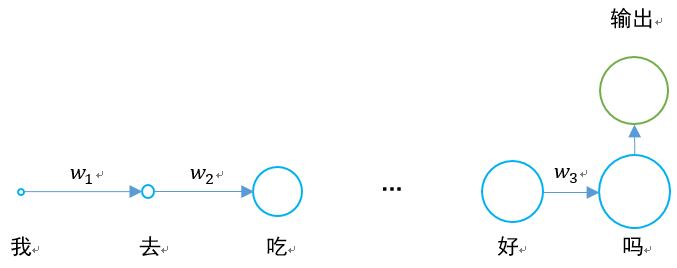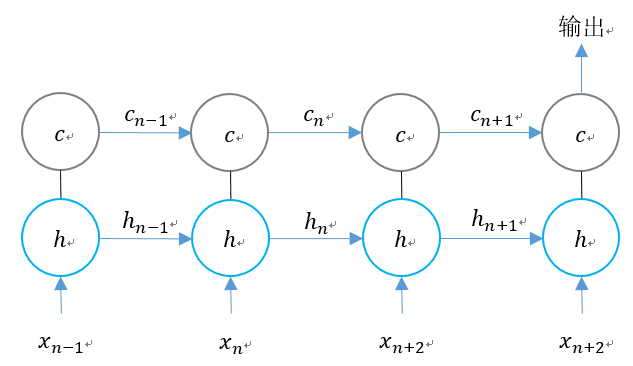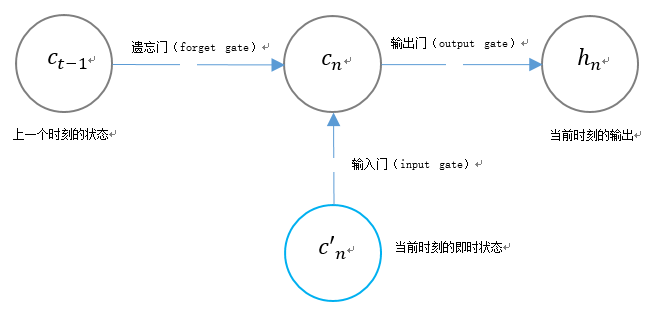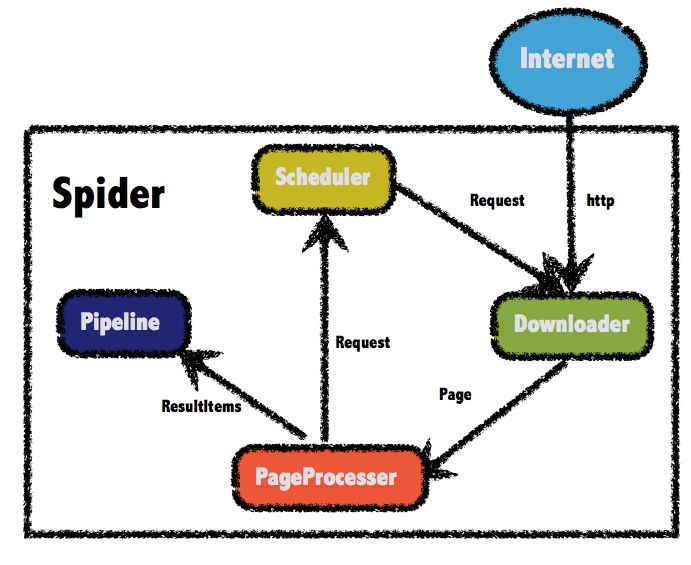神经网络学习小记录3——利用tensorflow构建长短时记忆网络(LSTM)
神经网络学习小记录3——利用tensorflow构建长短时记忆网络(LSTM)
- 学习前言
- LSTM简介
- 1、RNN的梯度消失问题
- 2、LSTM的结构
- 3、LSTM独特的门结构
- tensorflow中LSTM的相关函数
- tf.contrib.rnn.BasicLSTMCell
- tf.nn.dynamic_rnn
- 全部代码
学习前言
又出去和女朋友快乐的玩耍了,但是不要忘了学习噢。
LSTM简介
1、RNN的梯度消失问题
在过去的时间里我们学习了RNN循环神经网络,其结构示意图是这样的:
其存在的最大问题是,当w1、w2、w3这些值小于0时,如果一句话够长,那么其在神经网络进行反向传播与前向传播时,存在梯度消失的问题。
0.925=0.07,如果一句话有20到30个字,那么第一个字的隐含层输出传递到最后,将会变为原来的0.07倍,相比于最后一个字的影响,大大降低。
其具体情况是这样的:
长短时记忆网络就是为了解决梯度消失的问题出现的。
2、LSTM的结构
原始RNN的隐藏层只有一个状态h,从头传递到尾,它对于短期的输入非常敏感。
如果我们再增加一个状态c,让它来保存长期的状态,问题就可以解决了。
对于RNN和LSTM而言,其两个step单元的对比如下。
我们把LSTM的结构按照时间维度展开:
我们可以看出,在n时刻,LSTM的输入有三个:
1、当前时刻网络的输入值;
2、上一时刻LSTM的输出值;
3、上一时刻的单元状态。
LSTM的输出有两个:
1、当前时刻LSTM输出值;
2、当前时刻的单元状态。
3、LSTM独特的门结构
LSTM用两个门来控制单元状态cn的内容:
1、遗忘门(forget gate),它决定了上一时刻的单元状态cn-1有多少保留到当前时刻;
2、输入门(input gate),它决定了当前时刻网络的输入c’n有多少保存到单元状态。
LSTM用一个门来控制当前输出值hn的内容:
输出门(output gate),它决定了当前时刻单元状态cn有多少输出。
tensorflow中LSTM的相关函数
tf.contrib.rnn.BasicLSTMCell
tf.contrib.rnn.BasicLSTMCell(num_units,forget_bias=1.0,state_is_tuple=True,activation=None,reuse=None,name=None,dtype=None)
- num_units:RNN单元中的神经元数量,即输出神经元数量。
- forget_bias:偏置增加了忘记门。从CudnnLSTM训练的检查点(checkpoin)恢复时,必须手动设置为0.0。
- state_is_tuple:如果为True,则接受和返回的状态是c_state和m_state的2-tuple;如果为False,则他们沿着列轴连接。False即将弃用。
- activation:激活函数。
- reuse:描述是否在现有范围中重用变量。如果不为True,并且现有范围已经具有给定变量,则会引发错误。
- name:层的名称。
- dtype:该层的数据类型。
在使用时,可以定义为:
lstm_cell = tf.contrib.rnn.BasicLSTMCell(self.cell_size, forget_bias=1.0, state_is_tuple=True)
在定义完成后,可以进行状态初始化:
self.cell_init_state = lstm_cell.zero_state(self.batch_size, dtype=tf.float32)
tf.nn.dynamic_rnn
tf.nn.dynamic_rnn(cell,inputs,sequence_length=None,initial_state=None,dtype=None,parallel_iterations=None,swap_memory=False,time_major=False,scope=None)
- cell:上文所定义的lstm_cell。
- inputs:RNN输入。如果time_major==false(默认),则必须是如下shape的tensor:[batch_size,max_time,…]或此类元素的嵌套元组。如果time_major==true,则必须是如下形状的tensor:[max_time,batch_size,…]或此类元素的嵌套元组。
- sequence_length:Int32/Int64矢量大小。用于在超过批处理元素的序列长度时复制通过状态和零输出。因此,它更多的是为了性能而不是正确性。
- initial_state:上文所定义的_init_state。
- dtype:数据类型。
- parallel_iterations:并行运行的迭代次数。那些不具有任何时间依赖性并且可以并行运行的操作将是。这个参数用时间来交换空间。值>>1使用更多的内存,但花费的时间更少,而较小的值使用更少的内存,但计算需要更长的时间。
- time_major:输入和输出tensor的形状格式。如果为真,这些张量的形状必须是[max_time,batch_size,depth]。如果为假,这些张量的形状必须是[batch_size,max_time,depth]。使用time_major=true会更有效率,因为它可以避免在RNN计算的开始和结束时进行换位。但是,大多数TensorFlow数据都是批处理主数据,因此默认情况下,此函数为False。
- scope:创建的子图的可变作用域;默认为“RNN”。
在LSTM的最后,需要用该函数得出结果。
self.cell_outputs, self.cell_final_state = tf.nn.dynamic_rnn(lstm_cell, self.l_in_y, initial_state=self.cell_init_state, time_major=False)
返回的是一个元组 (outputs, state):
outputs:LSTM的最后一层的输出,是一个tensor。如果为time_major== False,则它的shape为[batch_size,max_time,cell.output_size]。如果为time_major== True,则它的shape为[max_time,batch_size,cell.output_size]。
states:states是一个tensor。state是最终的状态,也就是序列中最后一个cell输出的状态。一般情况下states的形状为 [batch_size, cell.output_size],但当输入的cell为BasicLSTMCell时,states的形状为[2,batch_size, cell.output_size ],其中2也对应着LSTM中的cell state和hidden state。
整个LSTM的定义过程为:
def add_input_layer(self,):#X最开始的形状为(256 batch,28 steps,28 inputs)#转化为(256 batch*28 steps,128 hidden)l_in_x = tf.reshape(self.xs, [-1, self.input_size], name='to_2D')#获取Ws和BsWs_in = self._weight_variable([self.input_size, self.cell_size])bs_in = self._bias_variable([self.cell_size])#转化为(256 batch*28 steps,256 hidden)with tf.name_scope('Wx_plus_b'):l_in_y = tf.matmul(l_in_x, Ws_in) + bs_in# (batch * n_steps, cell_size) ==> (batch, n_steps, cell_size)# (256*28,256)->(256,28,256)self.l_in_y = tf.reshape(l_in_y, [-1, self.n_steps, self.cell_size], name='to_3D')def add_cell(self):#神经元个数lstm_cell = tf.contrib.rnn.BasicLSTMCell(self.cell_size, forget_bias=1.0, state_is_tuple=True)#每一次传入的batch的大小with tf.name_scope('initial_state'):self.cell_init_state = lstm_cell.zero_state(self.batch_size, dtype=tf.float32)#不是主列self.cell_outputs, self.cell_final_state = tf.nn.dynamic_rnn(lstm_cell, self.l_in_y, initial_state=self.cell_init_state, time_major=False)def add_output_layer(self):#设置Ws,BsWs_out = self._weight_variable([self.cell_size, self.output_size])bs_out = self._bias_variable([self.output_size])# shape = (batch,output_size)# (256,10)with tf.name_scope('Wx_plus_b'):self.pred = tf.matmul(self.cell_final_state[-1], Ws_out) + bs_out
全部代码
该例子为手写体识别例子,将手写体的28行分别作为每一个step的输入,输入维度均为28列。
import tensorflow as tffrom tensorflow.examples.tutorials.mnist import input_dataimport numpy as npmnist = input_data.read_data_sets("MNIST_data",one_hot = "true")BATCH_SIZE = 256 # 每一个batch的数据数量TIME_STEPS = 28 # 图像共28行,分为28个step进行传输INPUT_SIZE = 28 # 图像共28列OUTPUT_SIZE = 10 # 共10个输出CELL_SIZE = 256 # RNN 的 hidden unit size,隐含层神经元的个数LR = 1e-3 # learning rate,学习率def get_batch(): #获取训练的batchbatch_xs,batch_ys = mnist.train.next_batch(BATCH_SIZE)batch_xs = batch_xs.reshape([BATCH_SIZE,TIME_STEPS,INPUT_SIZE])return [batch_xs,batch_ys]class LSTMRNN(object): #构建LSTM的类def __init__(self, n_steps, input_size, output_size, cell_size, batch_size):self.n_steps = n_stepsself.input_size = input_sizeself.output_size = output_sizeself.cell_size = cell_sizeself.batch_size = batch_size#输入输出with tf.name_scope('inputs'):self.xs = tf.placeholder(tf.float32, [None, n_steps, input_size], name='xs')self.ys = tf.placeholder(tf.float32, [None, output_size], name='ys')#直接加层with tf.variable_scope('in_hidden'):self.add_input_layer()#增加LSTM的cellwith tf.variable_scope('LSTM_cell'):self.add_cell()#直接加层with tf.variable_scope('out_hidden'):self.add_output_layer()#计算损失值with tf.name_scope('cost'):self.compute_cost()#训练with tf.name_scope('train'):self.train_op = tf.train.AdamOptimizer(LR).minimize(self.cost)#正确率计算self.correct_pre = tf.equal(tf.argmax(self.ys,1),tf.argmax(self.pred,1))self.accuracy = tf.reduce_mean(tf.cast(self.correct_pre,tf.float32))def add_input_layer(self,):#X最开始的形状为(256 batch,28 steps,28 inputs)#转化为(256 batch*28 steps,128 hidden)l_in_x = tf.reshape(self.xs, [-1, self.input_size], name='to_2D')#获取Ws和BsWs_in = self._weight_variable([self.input_size, self.cell_size])bs_in = self._bias_variable([self.cell_size])#转化为(256 batch*28 steps,256 hidden)with tf.name_scope('Wx_plus_b'):l_in_y = tf.matmul(l_in_x, Ws_in) + bs_in# (batch * n_steps, cell_size) ==> (batch, n_steps, cell_size)# (256*28,256)->(256,28,256)self.l_in_y = tf.reshape(l_in_y, [-1, self.n_steps, self.cell_size], name='to_3D')def add_cell(self):#神经元个数lstm_cell = tf.contrib.rnn.BasicLSTMCell(self.cell_size, forget_bias=1.0, state_is_tuple=True)#每一次传入的batch的大小with tf.name_scope('initial_state'):self.cell_init_state = lstm_cell.zero_state(self.batch_size, dtype=tf.float32)#不是主列self.cell_outputs, self.cell_final_state = tf.nn.dynamic_rnn(lstm_cell, self.l_in_y, initial_state=self.cell_init_state, time_major=False)def add_output_layer(self):#设置Ws,BsWs_out = self._weight_variable([self.cell_size, self.output_size])bs_out = self._bias_variable([self.output_size])# shape = (batch,output_size)# (256,10)with tf.name_scope('Wx_plus_b'):self.pred = tf.matmul(self.cell_final_state[-1], Ws_out) + bs_outdef compute_cost(self):self.cost = tf.reduce_mean(tf.nn.softmax_cross_entropy_with_logits(logits = self.pred,labels = self.ys))def _weight_variable(self, shape, name='weights'):initializer = np.random.normal(0.0,1.0 ,size=shape)return tf.Variable(initializer, name=name,dtype = tf.float32)def _bias_variable(self, shape, name='biases'):initializer = np.ones(shape=shape)*0.1return tf.Variable(initializer, name=name,dtype = tf.float32)if __name__ == '__main__':#搭建 LSTMRNN 模型model = LSTMRNN(TIME_STEPS, INPUT_SIZE, OUTPUT_SIZE, CELL_SIZE, BATCH_SIZE)sess = tf.Session()sess.run(tf.global_variables_initializer())#训练10000次for i in range(10000):xs, ys = get_batch() #提取 batch dataif i == 0:#初始化datafeed_dict = {model.xs: xs,model.ys: ys,}else:feed_dict = {model.xs: xs,model.ys: ys,model.cell_init_state: state #保持 state 的连续性}#训练_, cost, state, pred = sess.run([model.train_op, model.cost, model.cell_final_state, model.pred],feed_dict=feed_dict)#打印精确度结果if i % 20 == 0:print(sess.run(model.accuracy,feed_dict = {model.xs: xs,model.ys: ys,model.cell_init_state: state #保持 state 的连续性}))
希望得到朋友们的喜欢。
有不懂的朋友可以评论询问噢。



































还没有评论,来说两句吧...